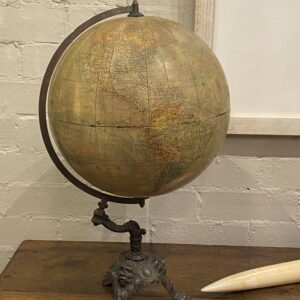Showing 49–64 of 452 resultsSorted by latest
Unusual late 19th century hand coloured lithographs of palms – Basil Besler.
After nearly two years of retirement sale and selling 2/3 of my entire stock at heavily reduced prices.
I was nearly at the end of trading, until my Son Charlie and daughter Allie informed me they would like to take over the family business.
This is very touching to me, I love their devotion to my business of 34 years. So SALE signs about to be removed pricing back to normal.
Arriving from Europe soon. Eight Beslers
Three framed 19th century Wolters pears
A rare 19th century Qing Dynasty gold leaf carved hanging panel of three Chinese gods.
Surrounded by foliage.
Carved entirely from one piece of wood.
A private purchase from some time ago.
Redouté – A decorative framed arrangement of five early 19th Century hand coloured citrus engravings.
These wonderful rare hand coloured copper engravings hung in my home for many years.
Now too wide to fit into my apartment, I’m selling.
1830 H.77cm W.175cm
Photography by Russell Winnell Photography
‘Upper reaches of the Avon River Gippsland’
Continually changing art around in my apartment.
Today I added Mali Moir’s ‘Cape Warthog’ moving Lucinda Chambers ‘Long Distance Love’
above the Italian retro rosewood sideboard.
I’m also trying Martin Tighe’s ‘Still Water’
Keeping Lydia Ciconte’s ‘Bush Fire Burning’ in the entrance, above the mid 18th century
English oak low dresser.
Looking forward to Russell Winnell photographing all when completed very soon…
‘Bathers’ Oil by Gustav Michael Pillig
Oil on canvas
Group of Females Bathing Nude
67x51cm
Gustav Michael Pillig
1877 Gelsenkirchen – 1956 Melbourne
Countryside Landscape Oil by Gustav Michael Pillig
Oil on board
29x24cm
Gustav Michael Pillig
1877 Gelsenkirchen – 1956 Melbourne
Restoration of German Terrestrial Globe
Taking apart, removing old glues, packing the interior for stability, re-glueing and holding glues together.
Then watercoloring the damages out.
Wonderful outcome.
Unusual contemporary brass sculptured horse head on stand
I purchased this unusual sculpture from a supplier recently.
I’ve featured in a display and taken home to play with.
This morning I’ve ordered two more to sell, as I’m keeping this one!
DM me for pricing.
H.44cm
W.12cm
D.22cm
‘The Gatherer’ Oil on Canvas. 107x101cm
A decorative antiqued visual montage of the artists favourite objects.
The pretty girl has gathered a pomegranate and auricula flower from the display.
Inspired by 18th – 19th century New England naive portraiture art.
In foreground
Auricula flowers in full bloom
A wooden jardinier with overflowing magnolias
A delftware blue and white urn and pomegranates.
Finished with an antiqued glaze.
107 x 101 cm
Oil on canvas 2022
Below,
An unusual 19th Century French Fruitwood, Burr Elm and Oak Dough bin
Resting on a Wide Kilim Hall Rug. ‘Ardabil’
North East Iran
Wide Kilim Hall Rug
First half 20th Century
In good sound condition
4.8m x 1.36m
Unusually large 18th Century blue and white,
Dr Wall Worcester jug.
I purchased this privately over 30 years ago. I’ve had in my private collection and used in many displays and advertisements over the years.
A decorative 19th century English acanthus leaf styled stoneware jug.
Unusually large 19th century Masons Ironstone mug (my private collection)
Early 19th century English Masons Ironstone jug.
Dated 1813.
Three bright, attractive Sunflower paintings
Recently found these three Sunflower paintings in my storeroom.
Reasonably priced to move on..
80 x 80cm
59 x 49cm
50 x 60cm
Visiting Customers over Easter
I visited nearby customers today, to see the framing Vicki Hutchins
did for the three 18th century Elizabeth Blackwells I sold them.
While there I enjoyed some of their other pieces, including the decorative
18th century French walnut panetiere and petrin/dough bin/jardinier.
Three beautiful Botanicals, newly framed.
Elizabeth Blackwell (nee Blachrie) was among the first women to achieve fame as a botanical illustrator.
She was born in Aberdeen in about 1700, but moved to London after she married. She undertook an ambitious project to raise money to pay her husband’s debts and release him from debtors’ prison.
Her project was a book called ‘A Curious Herbal’.
She learned that physicians required a reference book which documented the medicinal qualities of plants and herbs. In order to develop the publication she examined and drew specimens of plants available in the Chelsea Physic Garden. Sir Hans Sloane provided financial support to publish ‘A Curious Herbal’.
Elizabeth Blackwell is notable for being one of the first botanical artists to personally etch and engrave her own designs. This saved the expense of hiring a professional engraver. In total, the enterprise took Blackwell six full years to complete and in the end she was able to release her husband from prison. ‘A Curious Herbal’ was published between 1737 and 1739.
The book contained the first illustrations of many odd-looking, unknown plants from the New World.
1686 – 1986
Notice how even a retro made semi Chippendale style dining chair can match so well with a striking piece of art 300 years older.
Contemporary framing can completely change the look of a copper engraving, painting, lithograph, even old photos. It’s not hard.
These chairs were unattractive, dark and had shocking patterned upholstery.
Once again, it’s not too hard to improve a chair.
I have these in a window display this week.
Quite eye catching, along with the descriptions of both.
As always it’s important to create interesting window displays















